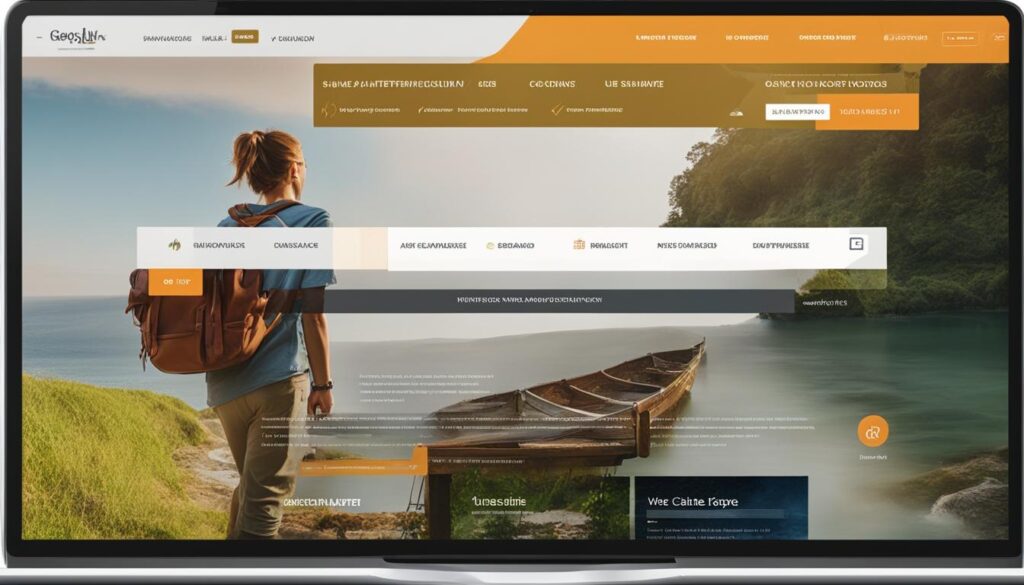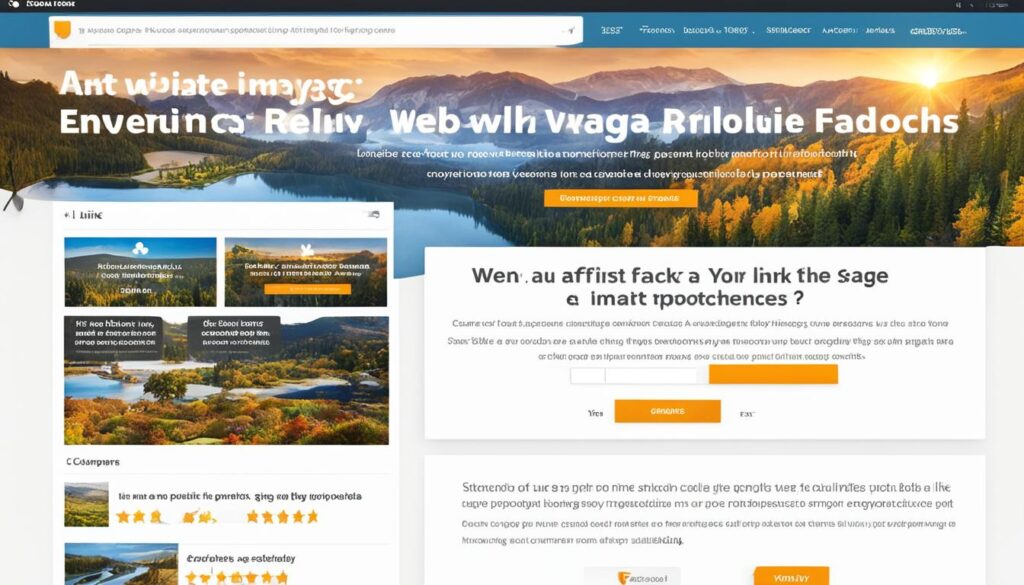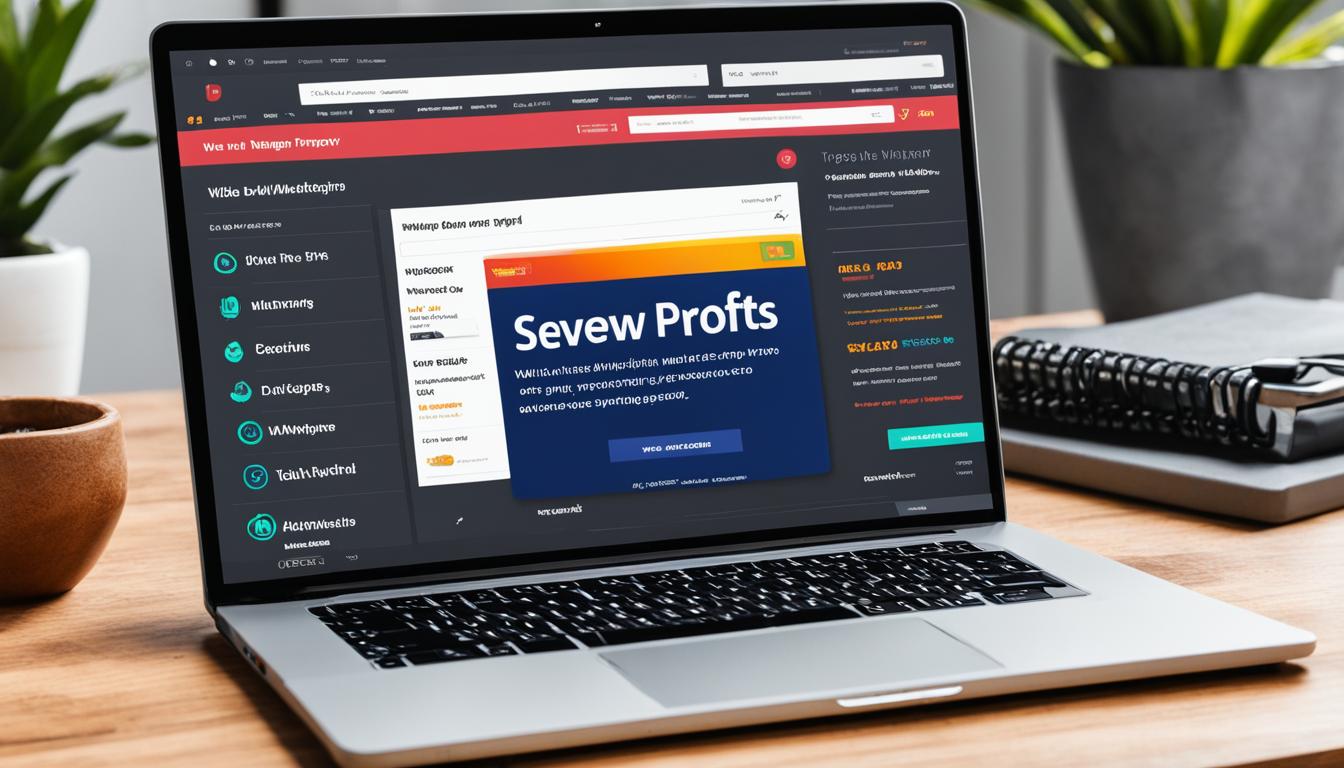Welcome to our blog, where we share valuable insights on web design for affiliate marketing. As affiliate marketers ourselves, we understand the importance of creating a visually appealing and user-friendly website that maximizes profits and drives growth. In this article, we will explore the key strategies and best practices for designing an effective website that attracts visitors, encourages conversions, and ultimately boosts your affiliate marketing success.
When it comes to web design for affiliate marketing, it’s crucial to strike a balance between aesthetics and functionality. Your website should not only captivate users with its visual appeal but also provide an intuitive and seamless browsing experience. By implementing effective design strategies, you can optimize your site to generate increased commissions and stand out amidst the competition.
Key Takeaways:
- Visually appealing and user-friendly web design is essential for maximizing profits in affiliate marketing.
- Choose products that offer high commissions and are relevant to your target audience when designing your website.
- Generate traffic and minimize competition by incorporating effective SEO strategies into your website design.
- Build a user-friendly website by focusing on usability, clear navigation, and valuable content.
- Optimize your website for mobile users to reach a wider audience and increase conversions.
Stay tuned as we delve into each of these topics in detail, providing valuable insights and practical tips to help you create a winning web design for your affiliate marketing endeavors. Let’s optimize your profit together!
The Goal of Affiliate Marketing
A successful affiliate marketing website is designed with a specific goal in mind: to drive traffic and generate sales through affiliate links. In order to achieve this, our team of web developers focuses on creating engaging, informative, and easy-to-navigate websites that captivate visitors and encourage them to take action.
Our approach to web design for affiliate marketing is centered around promoting affiliate products and providing a seamless user experience. By strategically designing the website layout and incorporating compelling visuals and content, we help affiliate marketers maximize their chances of success in this highly competitive industry.
When visitors arrive at the affiliate marketing website, it’s crucial that they find exactly what they’re looking for and are enticed to click on affiliate links. We achieve this by carefully organizing and presenting information, utilizing intuitive navigation menus, and implementing effective call-to-action elements.
Throughout the design process, we prioritize creating a visually appealing website that aligns with the target audience’s preferences and expectations. By combining aesthetics and functionality, we ensure that the affiliate marketing website becomes a powerful tool for driving conversions and boosting revenue.
Creating a visually appealing and user-friendly website is essential for achieving the goals of affiliate marketing. Let us help you design a website that stands out in this competitive industry and drives impressive results.
Choosing the Right Products

When designing an affiliate marketing website, one of the key factors to consider is choosing the right products to promote. It is important to select products that not only offer high commissions but are also relevant to your target audience. By researching and promoting products with strong affiliate programs, you can increase your chances of maximizing earnings and generating conversions.
Highlighting the Products
Web design plays a crucial role in showcasing the products you are promoting on your affiliate marketing website. The design should aim to captivate visitors and entice them to make a purchase through your affiliate links. By strategically placing product information, reviews, and offers on your website, you can create a compelling environment that motivates visitors to take action.
“Choosing the right products to promote is like laying a strong foundation for your affiliate marketing success.”
Relevant Information and Reviews
Providing relevant information, reviews, and comparisons of the products you are promoting is essential in building trust and credibility with your audience. Users appreciate transparency and being well-informed before making a purchase. Incorporating product comparisons, customer testimonials, and detailed descriptions can significantly influence their decision-making process.
Effectively presenting this information through your website’s design ensures that visitors have access to the necessary details they need to make an informed purchase. Engaging visuals, clear product descriptions, and easy navigation contribute to a positive user experience, increasing the likelihood of conversions.
Image:
| Benefits of Choosing the Right Products | Challenges of Selecting the Wrong Products |
|---|---|
| Higher commission rates | Low conversion rates |
| Increased target audience interest | Lack of audience engagement |
| Greater chances of generating sales | Missed revenue opportunities |
| Improved credibility and trust | Damaged reputation and brand image |
Choosing the right products to promote on your affiliate marketing website sets the stage for success. By leveraging effective web design strategies, such as highlighting the products, providing relevant information and reviews, you can increase your chances of driving conversions and maximizing your earnings. Remember, selecting the right products is like laying the foundation for a profitable affiliate marketing venture.
Importance of Traffic and Competition
When it comes to affiliate marketing success, generating traffic and minimizing competition are two crucial factors to consider. As an affiliate marketer, you want your website to attract interested readers and stand out from the competition. To achieve this, effective web design plays a key role in increasing website visibility and improving click-through rates.
One way to drive more traffic to your site is by creating high-quality content that appeals to your target audience. By producing informative and engaging articles, blog posts, and videos, you can attract visitors who are interested in the products or services you promote. Additionally, targeting low competition keywords can help your website rank higher in search engine results, making it easier for potential customers to find you.
Optimizing your website design for search engines is another crucial step in driving traffic and standing out from the competition. By incorporating effective SEO strategies such as keyword optimization, meta tags, and internal linking, you can help search engines recognize the relevancy and value of your website. This will ultimately result in higher rankings, increased visibility, and more organic traffic.
Benefits of Driving Traffic and Minimizing Competition
Driving traffic to your affiliate marketing website has numerous benefits. First, it increases the chances of potential customers clicking on your affiliate links and making a purchase, thus boosting your commissions. Additionally, a steady flow of traffic indicates that your website is generating interest and gaining credibility in your niche.
Minimizing competition is equally important. By targeting low competition keywords and optimizing your website design, you can position yourself as a unique and authoritative voice in your industry. This not only attracts more traffic but also helps differentiate you from other affiliate marketers offering similar products or services. By effectively standing out from the competition, you increase your chances of capturing the attention and loyalty of potential customers.
In order to drive traffic and minimize competition, it’s essential to continually monitor and analyze the effectiveness of your web design and SEO strategies. By staying on top of industry trends, adjusting your approach, and optimizing your website, you can continue to attract valuable traffic and increase your affiliate marketing success.
| Benefits of Driving Traffic | Benefits of Minimizing Competition |
|---|---|
| Higher click-through rates on affiliate links | Increased credibility and authority in your niche |
| Greater chances of earning commissions | Ability to stand out from other affiliate marketers |
| Improved website visibility and rankings | Increased attention and loyalty from potential customers |
| Higher chances of capturing valuable leads | Distinctive positioning in the marketplace |
Building a User-Friendly Website

Creating a user-friendly website is crucial for the success of your affiliate marketing endeavors. A website with a clean and intuitive design not only attracts visitors but also ensures they can easily navigate through your content and find the information they need to make informed decisions.
When designing your affiliate website, incorporate key features that enhance the user experience and make it effortless for visitors to engage with your content and affiliate links. Consider implementing the following:
- Clear navigation menus: Organize your website’s content into logical sections and provide clear links in your navigation menus for easy access to different pages and categories.
- Search functionality: Include a search bar on your website to help visitors quickly find specific information or products they are interested in.
- Easy-to-use contact forms: Make it convenient for visitors to reach out to you by incorporating user-friendly contact forms on your website. This encourages communication and allows you to build relationships with your audience.
By prioritizing usability and providing valuable content, you can create a positive user experience that builds trust and encourages visitors to engage with your affiliate links. Remember, the more user-friendly your website is, the more likely visitors are to convert into paying customers.
Here’s a visual representation of the key elements to focus on when designing a user-friendly affiliate marketing website:
| User-Friendly Website Elements | Benefits | Key Actions |
|---|---|---|
| Clear navigation menus | Easy access to different sections and pages | Organize content logically and include prominent navigation menus |
| Search functionality | Quickly find specific information or products | Include a search bar on your website |
| Easy-to-use contact forms | Convenient communication with visitors | Incorporate user-friendly contact forms |
By implementing these user-friendly elements, you’ll create a seamless browsing experience that keeps visitors engaged and increases the likelihood of conversions. Now, let’s explore how to choose the right platform for your affiliate marketing website in the next section.
Choosing the Right Platform

When it comes to designing a website for affiliate marketing, choosing the right platform is crucial. With so many options available, it’s important to select a platform that aligns with your goals and offers the necessary features to support your affiliate marketing efforts.
Two popular platforms that are often recommended for affiliate marketing websites are WordPress and website builders like Wix and Squarespace. These platforms provide flexibility, ease of use, and a range of customizable templates and plugins to enhance the design and functionality of your website.
WordPress is a versatile content management system (CMS) that allows for complete customization and control over your website. It offers a wide array of themes and plugins specifically designed for affiliate marketing, making it a popular choice among marketers. With WordPress, you have the freedom to create a professional and visually appealing website without the need for extensive coding knowledge.
On the other hand, website builders like Wix and Squarespace provide intuitive drag-and-drop interfaces, simplifying the website-building process. These platforms offer a wide range of professionally-designed templates that can be easily customized to suit your brand and niche. With their user-friendly interfaces and built-in SEO features, website builders are an excellent choice for beginners and marketers who want to quickly launch their affiliate websites.
Comparison between WordPress and Website Builders:
| WordPress | Website Builders (Wix, Squarespace) |
|---|---|
| Highly customizable | Easy drag-and-drop customization |
| Extensive selection of themes and plugins | Professionally-designed templates |
| Requires basic coding knowledge | No coding knowledge required |
| Ideal for advanced users and those looking for complete control | Perfect for beginners and quick website setup |
Ultimately, the choice between WordPress and website builders depends on your preferences and skill level. If you’re comfortable with coding and want greater flexibility and control, WordPress is an excellent option. However, if you prefer a user-friendly interface and a streamlined website-building experience, website builders like Wix and Squarespace may be the best fit for you.
Regardless of the platform you choose, remember to prioritize web design for affiliate marketing. Your website should be visually appealing, user-friendly, and optimized for conversions. By selecting the right platform and designing a website that resonates with your target audience, you can create a strong online presence for your affiliate marketing business.
When it comes to web design for affiliate marketing, the choice of platform is a critical decision. With platforms like WordPress and website builders offering a range of features and customization options, you have the tools to create a visually appealing and effective affiliate website.
Optimizing for Mobile Users

In today’s digital landscape, mobile devices have become an integral part of our daily lives. With an increasing number of people relying on their smartphones and tablets for browsing the internet, it is crucial for affiliate marketers to optimize their websites for mobile users. By ensuring that your website is mobile-friendly, you can reach a wider audience and increase conversions.
One of the key aspects of mobile optimization is responsive web design. This approach allows your website to adapt to different screen sizes and resolutions, providing a seamless and user-friendly experience across all devices. By using responsive design techniques, you can ensure that your website’s layout, navigation, and content adjust perfectly to fit the screens of smartphones and tablets.
Mobile optimization goes beyond just improving user experience. It also plays a significant role in search engine rankings. In recent years, major search engines like Google have prioritized mobile-friendly websites in their algorithms. This means that having a mobile-optimized website can positively impact your website’s visibility in search engine results.
Providing a mobile-friendly experience involves more than just shrinking down the content to fit smaller screens. It requires considering the unique needs and behaviors of mobile users. Here are a few best practices to optimize your website for mobile:
- Ensure fast load times: Mobile users have shorter attention spans and expect websites to load quickly. Optimizing images, leveraging browser caching, and minimizing code can help speed up load times.
- Simplify navigation: Mobile screens are smaller, so it’s important to create a clear and concise navigation menu that allows users to easily find what they’re looking for.
- Streamline forms: Filling out forms on mobile devices can be tedious. Simplify the process by reducing the number of fields and using inputs optimized for touchscreens.
- Highlight essential information: Identify the key information that mobile users are likely to seek, such as product details or contact information, and make it easily accessible.
By prioritizing mobile optimization, you can create a seamless browsing experience for your audience and increase the chances of converting visitors into customers.
Incorporating Call-to-Action Elements

A successful affiliate marketing website relies on strong call-to-action elements to drive conversions. These strategic buttons and links placed throughout the website play a vital role in guiding visitors towards the desired action, such as making a purchase or signing up for a newsletter. By optimizing the design of these elements, we can create visually appealing and compelling calls to action that effectively engage users.
When designing call-to-action elements, it is crucial to ensure they clearly communicate the intended action and stand out from the rest of the content. By utilizing eye-catching colors, typography, and placement, we can capture the attention of visitors and encourage them to take the desired action.
“The design of your call-to-action elements should align with the overall aesthetic of your website, while still standing out and grabbing the attention of your visitors.”
A prominent call-to-action button placed strategically on a product page, for example, can prompt visitors to make an immediate purchase. Similarly, including a call-to-action link within engaging blog content can inspire readers to sign up for a newsletter or explore related products and services.
Best Practices for Call-to-Action Design:
- Use clear and concise wording that conveys a sense of urgency or excitement.
- Create a visually distinct button or link design that is easily recognizable.
- Place the call-to-action elements in prominent positions, ensuring they are readily visible.
- Utilize contrasting colors to make the buttons or links stand out.
- Optimize for mobile devices to ensure a seamless user experience across all platforms.
By incorporating these best practices, we can increase the effectiveness of call-to-action elements in driving conversions and boosting affiliate marketing success.
When strategically implemented, call-to-action elements can be powerful tools for achieving desired outcomes on an affiliate marketing website. By carefully crafting their design and placement, we can guide visitors towards taking valuable actions that boost conversions and increase our earning potential.
Enhancing the User Experience

In the world of affiliate marketing, providing a seamless user experience is essential for attracting visitors, increasing conversions, and building a loyal audience. To enhance the user experience on your affiliate marketing website, there are several key factors to consider.
1. Page Load Speed
The speed at which your website loads can significantly impact user satisfaction and retention. Slow-loading pages frustrate visitors and increase the likelihood of them clicking away before exploring your affiliate offers. To ensure optimal page load speed:
- Optimize image sizes and formats.
- Minify HTML, CSS, and JavaScript files.
- Enable caching to reduce server response time.
2. Easy Navigation
Intuitive navigation is crucial for guiding visitors through your website and helping them find the information they’re seeking. Consider the following navigation best practices:
- Use clear and descriptive menu labels.
- Organize your content into logical categories and subcategories.
- Include a search bar to facilitate quick searches.
3. Valuable and Relevant Content
Content is king in affiliate marketing, and providing valuable and relevant content is key to engaging your audience. When designing your website, focus on:
- Creating in-depth product reviews and comparisons.
- Offering informative blog posts and tutorials related to your niche.
- Ensuring the accuracy and quality of the information you provide.
Remember, the more value you offer to your visitors, the more likely they are to trust your recommendations and click on your affiliate links.
4. User Testing and Feedback
Regular user testing and gathering feedback are essential for identifying areas of improvement and fine-tuning your website’s user experience. Consider implementing the following strategies:
“We strongly recommend conducting usability tests to gain valuable insights into how users interact with your website. Additionally, encourage visitors to provide feedback through surveys or contact forms to understand their pain points and expectations.”
By taking the time to understand your users’ needs and preferences, you can make data-driven adjustments that improve the overall usability and satisfaction of your website.
Remember, an enhanced user experience not only increases the chances of conversions but also encourages visitors to return to your website in the future. By prioritizing page load speed, easy navigation, valuable content, and user feedback, you can create a user-friendly environment that sets your affiliate marketing website apart from the competition.
| Benefits of Enhancing User Experience in Affiliate Marketing | Ways to Enhance User Experience |
|---|---|
| 1. Increased conversions and click-through rates | 1. Optimize page load speed |
| 2. Improved user satisfaction and retention | 2. Ensure easy navigation |
| 3. Enhanced brand reputation and credibility | 3. Provide valuable and relevant content |
| 4. Higher chances of repeat visits and referrals | 4. Conduct user testing and gather feedback |
Leveraging SEO for Affiliate Marketing

When it comes to maximizing the success of your affiliate marketing website, SEO is an essential tool in driving organic traffic. By implementing effective SEO strategies into your web design, such as keyword research, meta tags, and optimized content, you can improve your search engine rankings and attract more targeted visitors.
Staying updated with the latest SEO best practices and algorithms is crucial to ensure your website remains visible and competitive in search engine results. By keeping your content relevant, engaging, and optimized, you can increase your chances of reaching your target audience and driving conversions. Let’s explore key SEO strategies that can help you achieve affiliate marketing success:
1. Keyword Research
Keyword research is the foundation of successful SEO. By identifying and targeting the right keywords, you can optimize your web content to rank higher in search engine results. This involves researching the keywords that your target audience is using when searching for products or information related to your affiliate marketing niche.
Using keyword research tools, such as Google Keyword Planner or SEMrush, you can discover high-performing keywords with low competition. Incorporate these keywords naturally into your website’s content, titles, headings, meta tags, and image alt tags to increase your visibility in search engine results pages.
2. Meta Tags
Meta tags provide search engines with information about your website’s content. By optimizing your meta tags, including the title tag and meta description, you can improve your website’s click-through rate and attract more targeted visitors.
Ensure that your title tag accurately reflects the content of your webpage and contains relevant keywords. The meta description should be compelling and concise, enticing users to click on your website in search results.
3. Optimized Content
Creating high-quality, informative, and engaging content is essential for improving your website’s visibility in search engine results. By integrating your target keywords strategically within your content, headers, and subheadings, you can signal to search engines that your website is relevant to users’ search queries.
Ensure that your content is well-structured, easy to navigate, and provides value to your audience. Incorporating compelling visuals and multimedia elements can also enhance the user experience and encourage visitors to stay on your website longer.
4. Responsive Design
In the era of mobile browsing, responsive design is critical for optimizing your affiliate marketing website. With more users accessing the internet through mobile devices, it’s essential to ensure that your website displays properly and functions seamlessly across different screen sizes and resolutions.
A responsive design not only improves user experience but is also a ranking factor for search engines. Prioritize mobile optimization by using responsive website templates and testing your website’s performance on various devices to provide a seamless experience for all users.
5. Backlinks and Internal Linking
Building a robust backlink profile is crucial for improving your website’s authority and visibility in search engine rankings. Seek opportunities to acquire high-quality backlinks from reputable websites in your niche. This can be achieved through guest blogging, creating valuable content that others want to link to, or networking with industry influencers.
Additionally, internal linking within your website helps search engines understand the structure and hierarchy of your content. Link relevant pages within your website to create a cohesive user experience and enhance your website’s search engine optimization.
By leveraging SEO strategies in your web design, you can increase your website’s visibility, attract targeted traffic, and ultimately drive more conversions for your affiliate marketing efforts. Stay up to date with the latest SEO trends and adapt your strategies accordingly to achieve long-term success.
Monitoring and Analytics

Monitoring website performance and analyzing user behavior is essential for optimizing an affiliate marketing website. By utilizing analytics tools, such as Google Analytics, we can track key metrics like traffic sources, conversion rates, and user engagement. This allows us to make data-driven decisions and optimize the website design for better results.
Regular monitoring and analysis help us identify our strengths, weaknesses, and opportunities for improvement. By understanding how visitors interact with our website, we can make informed adjustments to enhance the user experience and drive conversions.
One of the key advantages of using analytics tools is the ability to track traffic sources. We can identify which channels are driving the most visitors to our website, whether it’s organic search, social media, or referral traffic. This insight allows us to focus our marketing efforts on the most effective channels and budget our resources more efficiently.
Conversion rates are another crucial metric to monitor. By analyzing the conversion funnel, we can identify any bottlenecks or areas where visitors drop off before completing a desired action, such as making a purchase or signing up for a newsletter. With this information, we can make targeted improvements to our website design and optimize the conversion process.
“Analytics is the compass that guides our decision-making process. By understanding data-driven insights, we can continuously refine our website design and improve our performance in the competitive affiliate marketing industry.”
Furthermore, user engagement metrics provide valuable insights into how visitors interact with our website. By analyzing metrics such as bounce rate, time on page, and click-through rates, we can evaluate the effectiveness of our content and design elements. This allows us to create a more engaging user experience that keeps visitors on our site longer and encourages them to explore more of our affiliate offerings.
| Metric | Definition |
|---|---|
| Bounce Rate | The percentage of visitors who leave the website without interacting further. |
| Time on Page | The average amount of time visitors spend on a specific page. |
| Click-Through Rate (CTR) | The ratio of users who clicked on a specific link to the number of total users who viewed the page. |
The importance of data-driven decision-making
Data-driven decision-making is the key to optimizing our affiliate marketing website. By analyzing the metrics provided by analytics tools, we gain valuable insights that help us make informed changes to our design and content strategy. This allows us to continually improve our website’s performance, increase conversions, and drive growth in our affiliate marketing business.
“Monitoring and analyzing website performance is not a one-time task; it’s an ongoing process. By regularly reviewing our analytics data, we stay ahead of the competition and make strategic decisions that lead to long-term success.”
Conclusion
Designing an effective website for affiliate marketing requires careful planning and consideration. At WebsiteDesigner.Business, we understand the importance of implementing the right strategies to maximize profits and drive growth in the competitive affiliate marketing industry.
By choosing the right products to promote and optimizing for SEO, affiliate marketers can attract targeted visitors and increase their chances of generating conversions. A visually appealing and user-friendly web design is crucial in establishing a strong online presence and encouraging visitors to engage with affiliate links.
Continuous monitoring, analysis, and optimization of the website design are key to staying ahead of the competition and achieving long-term success. It’s essential to track important metrics, like traffic sources and conversion rates, to make data-driven decisions and identify opportunities for improvement.
Experience the power of effective web design for affiliate marketing success. Visit our WebsiteDesigner.Business today to order the best web design plan optimized for your affiliate marketing needs. Together, we can create a website design that attracts visitors, generates conversions, and helps you achieve your affiliate marketing goals.
FAQ
What role does web design play in affiliate marketing?
Web design plays a crucial role in maximizing profits for affiliate marketing. It helps create a visually appealing and user-friendly website that attracts visitors and encourages them to click on affiliate links.
What is the goal of affiliate marketing?
The goal of affiliate marketing is to drive traffic and generate sales through affiliate links. Marketers aim to create engaging websites that promote affiliate products and provide a seamless user experience.
How do I choose the right products for my affiliate marketing website?
When designing a website for affiliate marketing, it’s important to choose products that offer high commissions and are relevant to the target audience. Research and promote products with strong affiliate programs to maximize earnings.
Why is traffic and competition important in affiliate marketing?
Generating traffic and minimizing competition are key factors in affiliate marketing success. Targeting low competition keywords and creating content that attracts interested readers can help increase website visibility and improve click-through rates.
How can I build a user-friendly website for affiliate marketing?
A user-friendly website is essential for affiliate marketing success. Focus on creating a clean and intuitive design, with clear navigation menus, search functionality, and easy-to-use contact forms. Providing valuable content will also enhance the user experience.
What platform should I use for my affiliate marketing website?
WordPress, Wix, and Squarespace are popular website platforms that offer flexibility and ease of use for affiliate marketers. These platforms provide customizable templates and plugins to enhance the design and functionality of your website.
How can I optimize my affiliate marketing website for mobile users?
It’s crucial to optimize your affiliate marketing website for mobile devices. Using responsive design techniques ensures your website adapts to different screen sizes and resolutions. Mobile-friendly websites provide a better user experience and improve search engine rankings.
How important are call-to-action elements on an affiliate marketing website?
Strong call-to-action elements are essential for driving conversions on an affiliate marketing website. Strategically placing buttons and links throughout the website encourages visitors to take action, such as making a purchase or signing up for a newsletter.
How can I enhance the user experience on my affiliate marketing website?
Enhancing the user experience involves optimizing page load speed, easy navigation, and providing valuable and relevant content. Conducting user testing and gathering feedback can help identify areas for improvement and enhance the overall user experience.
How can I leverage SEO for my affiliate marketing website?
Incorporating SEO strategies into your website design, such as keyword research, meta tags, and optimized content, can improve search engine rankings and attract more targeted visitors. Staying up to date with the latest SEO best practices is crucial to remain visible and competitive.
How can I monitor and analyze my affiliate marketing website performance?
Utilizing analytics tools like Google Analytics allows you to track key metrics such as traffic sources, conversion rates, and user engagement. This data provides valuable insights for making data-driven decisions and optimizing your website design.

Leave a Reply